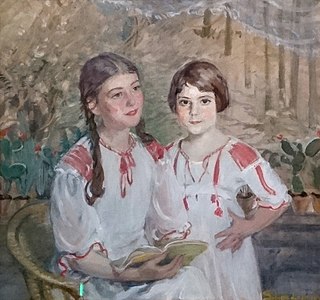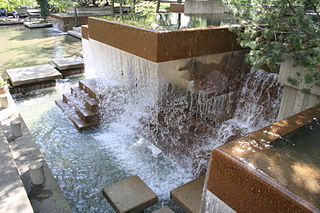
A landscape architect is a person who is educated in the field of landscape architecture. The practice of landscape architecture includes: site analysis, site inventory, site planning, land planning, planting design, grading, storm water management, sustainable design, construction specification, and ensuring that all plans meet the current building codes and local and federal ordinances.

The Olmsted Brothers company was a landscape architectural firm in the United States, established in 1898 by brothers John Charles Olmsted (1852–1920) and Frederick Law Olmsted Jr. (1870–1957), sons of the landscape architect Frederick Law Olmsted.

Richard Haag was an American landscape architect who was known for his role in Gas Works Park in Seattle, Washington and on the Bloedel Reserve on Bainbridge Island. Richard Haag's modernist and minimalist ideals also set the tone for Northwestern landscape design.
The American Society of Landscape Architects (ASLA) is a professional association for landscape architects in the United States. The ASLA's mission is to advance landscape architecture through advocacy, communication, education, and fellowship.

Cornelia Hahn Oberlander LL.D. was a German-born Canadian landscape architect. Her firm, Cornelia Hahn Oberlander Landscape Architects, was founded in 1953, when she moved to Vancouver.
M. Paul Friedberg, FASLA, is an American landscape architect.
Michael Robert Van Valkenburgh is an American landscape architect and educator. He has worked on a wide variety of projects in the United States, Canada, Korea, and France, including public parks, college campuses, sculpture gardens, city courtyards, corporate landscapes, private gardens, and urban master plans.

Sustainable landscape architecture is a category of sustainable design concerned with the planning and design of the built and natural environments.
James Corner is a landscape architect and theorist whose works exhibit a focus on "developing innovative approaches toward landscape architectural design and urbanism." His designs of note include Fresh Kills Park on Staten Island and the High Line in Manhattan, and Domino Park in Brooklyn, all in New York City.

Theodora Kimball Hubbard (1887-1935) was the first librarian of the Harvard School of Landscape Architecture, and a contemporary of and collaborator with many significant figures in landscape architecture in expanding the body of knowledge in that subject area.
Oehme, van Sweden & Associates is a Washington, D.C. based landscape architecture firm known for its focus on sustainability in landscape architecture. It was founded in 1975 by Wolfgang Oehme and James van Sweden. The firm is a proponent of the "New American Garden" style, which is characterized by large swaths of grasses and fields of perennials.

Peavey Plaza is a park plaza that serves as a public outdoor space in downtown Minneapolis, Minnesota at the south end of Nicollet Mall between South 11th and 12th Streets. The sunken plaza and its amphitheater were designed by landscape architect M. Paul Friedberg and built in 1975 alongside Orchestra Hall. The Cultural Landscape Foundation has deemed the plaza a "marvel of modernism" and it was named one of the top ten most endangered historical sites in Minnesota before its rehabilitation in 2019.
EDAW was an international landscape architecture, urban and environmental design firm that operated from 1939 until 2009. Starting in San Francisco, United States, the company at its peak had 32 offices worldwide. EDAW led many landscape architecture, land planning and master planning projects, developing a reputation as an early innovator in sustainable urban development and multidisciplinary design.

Sasaki is a design firm specializing in Architecture, Interior Design, Urban Design, Space Planning, Landscape Architecture, Ecology, Civil Engineering, and Place Branding. The firm is headquartered in Boston, Massachusetts, but practices on an international scale, with offices in Shanghai, and Denver, Colorado, and clients and projects globally.
Carol Roxane Johnson was a landscape architect and educator notable for being one of the first women in her field. She founded Carol R. Johnson Associates, a landscape architecture firm in Boston, and designed large-scale projects throughout the United States. She was also a professor at Harvard's Graduate School of Design. Johnson retired in 2016. She died on December 11, 2020, in Boothbay Harbor, Maine at the age of 91.
Sidney Herbert Hare, better known as S. Herbert Hare, was an American landscape architect and urban planner. Hare was the seventeenth president of the American Society of Landscape Architects.
Susan Child (1928–2018) was an American landscape architect. She completed many residential, public, and historic preservation projects in New England.
Harriet Pattison is an American landscape architect.

Michael Painter was an American landscape architect and urban designer based in San Francisco, California. He was a fellow of the American Society of Landscape Architects. His most notable project is the Presidio Parkway, a roadway through the Presidio National Park from the Golden Gate Bridge. Other notable projects include the John F. Kennedy Grave Site at Arlington National Cemetery, the Great Highway/Ocean Beach Re-Construction in San Francisco, Children's Playground in Golden Gate Park, the College of San Mateo, Twin Peaks overlook in San Francisco, Hunter's Point Hilltop Park in San Francisco, AT&T Administrative Center in San Ramon, Lafayette Park and the Blair House in Washington D.C., Aquatic Park in Berkeley, Hennepin Center in Minneapolis, State Compensation Insurance Fund in San Francisco, Genentech Campus in South San Francisco, the HP Corporate Headquarters in Palo Alto, and the Asilomar Conference Center in Monterey.
The Cultural Landscape Foundation (TCLF) is a 501(c)(3) non-profit founded in 1998 by Charles A. Birnbaum with a mission of “connecting people to places.”









